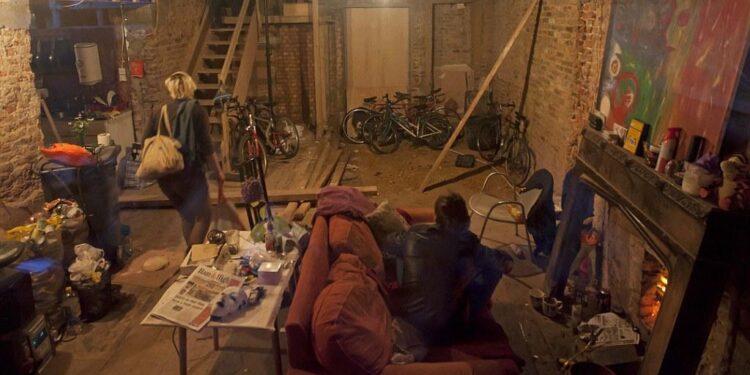In the heart of Amsterdam’s escalating housing crisis, a growing number of squatters are defiantly occupying vacant properties, challenging both landlords and authorities alike. As soaring rents and scarce affordable housing push the city’s residents to the brink, these squatters stand their ground, highlighting the human toll of one of Europe’s most severe urban housing shortages. This confrontation underscores a deepening social divide and raises pressing questions about property rights, urban policy, and the future of Amsterdam’s housing landscape.
Squatters Challenge Authorities as Housing Shortage Worsens in Amsterdam
As Amsterdam grapples with one of its most severe housing shortages in decades, groups of squatters are increasingly refusing to vacate abandoned buildings, sparking tense stand-offs with city officials. These activists argue that the growing number of empty properties could be better utilized to address the urgent demand for affordable living spaces. Citing skyrocketing rents and a lack of social housing initiatives, squatters assert their actions highlight the city’s failure to protect vulnerable residents. The city council, meanwhile, faces mounting pressure to enforce housing laws while exploring sustainable solutions to the crisis.
Key Factors Fueling the Squatting Movement:
- Over 30,000 households on waiting lists for social housing
- Vacancy rate of less than 1% in urban neighborhoods
- Rental prices in Amsterdam rising by 15% over the past year
- Strict regulations limiting new housing developments
| Year | Social Housing Units Added | Average Rent Increase (%) |
|---|---|---|
| 2021 | 1,200 | 8.0 |
| 2022 | 900 | 12.3 |
| 2023 | 750 | 15.0 |
Urban Housing Policies Under Pressure Amid Rising Occupancy Disputes
City officials in Amsterdam are grappling with an unprecedented wave of occupancy disputes that have stretched urban housing policies to their limits. As demand skyrockets and affordable rentals dwindle, squatters are increasingly occupying vacant properties, asserting their right to shelter amid soaring rents and a persistent shortage of available homes. This new reality challenges municipal strategies that traditionally balanced property rights with social welfare, pushing regulators to reconsider enforcement methods and support frameworks.
Key issues rapidly emerging from this crisis include:
- Legal ambiguity: Existing tenancy laws lack clarity in addressing unauthorized occupancy, resulting in prolonged court battles and inconsistent rulings.
- Housing supply deficit: The gap between demand and affordable housing units is widening, fueling frustration among both tenants and property owners.
- Community tensions: Neighborhoods divided over the presence of squatters face challenges in maintaining public order and cohesion.
| Policy Aspect | Current Status | Potential Reform |
|---|---|---|
| Eviction Procedures | Lengthy and costly | Streamlined legal pathways |
| Rent Control | Strict but outdated | Flexible rent caps |
| Social Housing Projects | Underfunded | Increased investment and incentives |
Experts Call for Comprehensive Reform to Address Amsterdam’s Shelter Crisis
Amid Amsterdam’s escalating housing emergency, policy experts and urban planners stress the urgent need for a multi-faceted strategy to alleviate the city’s shelter shortage. Current measures, critics argue, largely focus on short-term fixes like increasing temporary shelters, rather than addressing root causes such as soaring rental prices, restrictive zoning laws, and inadequate affordable housing stock. These conditions have created a volatile environment where squatters increasingly occupy vacant properties as a form of survival and protest. Experts emphasize that without comprehensive reform, this cycle of displacement and occupation will persist, exacerbating social tensions and deepening the divide between vulnerable communities and city officials.
Key areas highlighted for reform include:
- Expansion of affordable housing projects with government incentives for developers
- Revision of zoning and land use policies to allow greater residential density
- Streamlined processes for converting unused commercial spaces into livable units
- Improved tenant protections to prevent unwarranted evictions
- Investment in social services aimed at supporting the homeless population
| Proposed Measure | Expected Impact | Timeline |
|---|---|---|
| Affordable Housing Incentives | Increase housing availability by 20% | 2-4 years |
| Zoning Law Adjustments | Allow higher density, ease shortages | 1-2 years |
| Vacant Space Conversion | Utilize underused assets quickly | 6 months – 1 year |
Wrapping Up
As Amsterdam continues to grapple with a severe housing shortage, the persistence of squatters underscores the deep-rooted tensions between urgent social needs and regulatory frameworks. While authorities seek solutions to stabilize the housing market, the stand taken by these communities highlights the complexities of accessibility, affordability, and urban livability that city officials must address. The evolving situation remains a critical barometer of how European cities manage the balance between property rights and the right to shelter in times of crisis.















